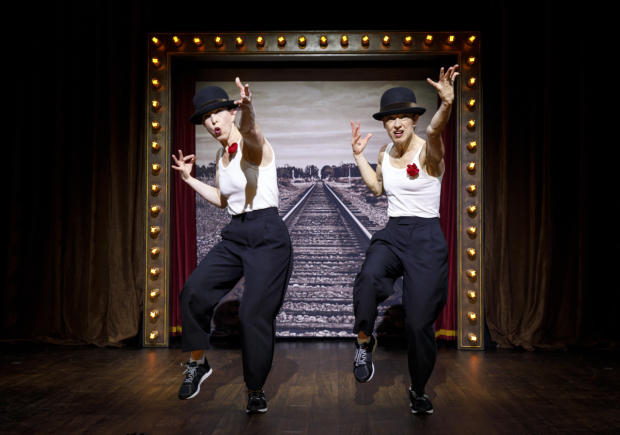One Night Only (Running as Long as We Can)

(© Joan Marcus)
Dance has never fallen tidily into the categories of either art or sport, but Monica Bill Barnes and Anna Bass make the distinction irrelevant with their oddball athletic theatrical dance piece One Night Only (Running as Long as We Can), a collaboration between Monica Bill Barnes & Company and WP Theater (formerly Women's Project Theater). Contrary to its title, the show is slated to run for more than one night, but only through October 8, yet after spending an evening with the bionic women who have made a life of pushing their minds and bodies to new extremes, it wouldn't seem out of character for them to keep extending until a Viking funeral were the only option.
To explain One Night Only presents a unique challenge, though the show is clarified slightly by the official Monica Bill Barnes & Company tagline, "bringing dance where it doesn't belong." In this case, the inappropriate place we find the art and/or sport of dance is the training gym — the unhallowed ground where all the blood, sweat, and tears are not yet masked by age-defying makeup and pained smiles that radiate the grace we audience members love to call "effortless." Effort, rather, is the main event at One Night Only — an element typically hidden in the world of art and yet glorified in the world of sports.
It becomes the charismatic Robert Saenz de Viteri's job to draw attention to the inherent discord between these two worlds. He calls the show like a play-by-play sports announcer while Barnes and Bass surround themselves with the trappings of old-fashioned show biz (sets and costumes by Kelly Hanson and lighting by Jane Cox, all designed with tongue-in-cheek simplicity). Bare bulbs frame the ladies as they enter on a pair of treadmills and de Viteri announces the 64-minute countdown to the end of the show (an ideal runtime, and with no threat of endless timeouts or a halftime). Vaudevillian wife beaters, high-waisted pants, and bowler hats are the costumes in which Barnes and Bass attempt to beat their record for consecutive spins (the androgynous outfits also strip them of gender norms in a fun and understated way). And an audience member is enlisted to rattle off every one of the dancers' career injuries, from broken bones to kidney stones, while Barnes and Bass continue their synchronized routine onstage. Their ages — 44 and 39, respectively — are also made public information from the start as de Viteri expounds on the dancers' status as veteran athletes painstakingly driving their bodies beyond their natural limits. And the sheer power behind their movement (not to mention some impressive musculature) is proof enough of these physical achievements.
In terms of content, there's not much beyond coordinated jogging, shadow boxing, and spinning (with a bonus lip-synched performance of Queen's "Don’t Stop Me Now.") And yet, once all the strangely entertaining nonsense percolates, you're left with a stack of thought-provoking nuggets. After all, as Barnes and Bass blend theater into sport, sport in the traditional sense begins to look a lot like theater. Does either one warrant the glory we attribute to the practitioners who go to such extremes? Does either one warrant the shame we pin on those who age out of their craft (i.e. everyone, no matter how strong your denial game is)? And on a subtler note, how do these pressures differ for women — a population already taught to feel the sting of age like a personal countdown clock to obsolescence? Boasting a history of unflagging fortitude, it's impossible to tell how keenly Bass and Barnes feel any of that underlying baggage. But in sports, as in art, it's the game face that matters.










